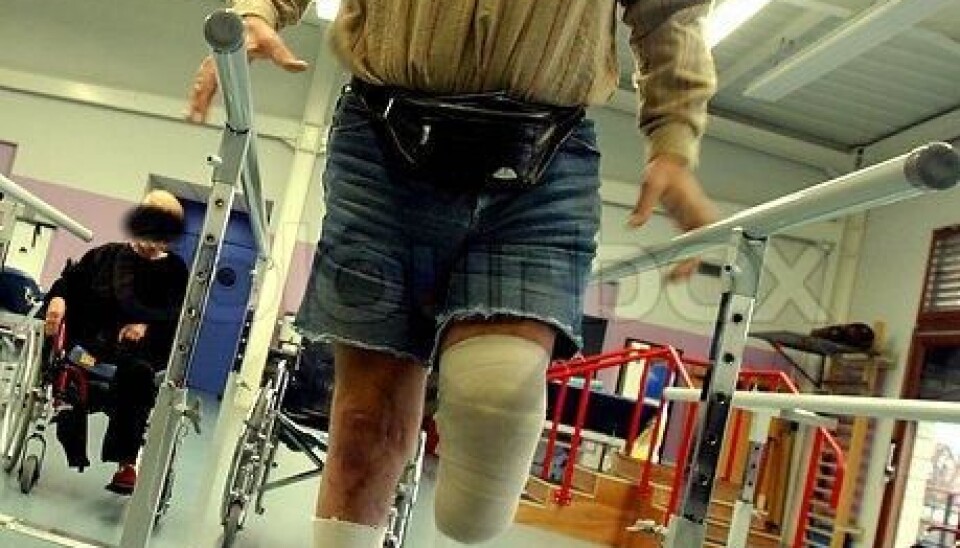
Phantom limb pains are permanent
Amputating a leg or an arm can lead to nerve cells forming knots (ganglions) that can be extremely painful for the patient, who feels a pain in the amputated limb. A new study shows that removing ganglions is not a solution, as they appear to regenerate.
People who have had an arm or a leg amputated often suffer from a new problem: phantom limb pains. Pains felt in amputated limbs can often be so intense that the patient simply cannot work or sleep, and the longevity of the pain can drive some patients to suicide.
These phantom limb pains are generated by knots of nerve cells (ganglions) that are formed because the nerves do not grow together properly after the amputation surgery.
Earlier studies have indicated that removing the ganglions can relieve phantom limb pains. However, a new Danish study shows this path to be wrong, as the pains often start again – sometimes even with greater strength than before.
“Our study indicates that this treatment [removing the ganglions] rarely has any effect and at times makes the situation worse,” says Lone Nikolajsen MD, PhD, an associate professor of anaesthesiology at Aarhus University and a researcher at the Danish Pain Research Centre at Aarhus University Hospital. She conducted the study as part of her recently finalised doctoral thesis.
Patients close to suicide
Our studies show that the pains will typically continue at unreduced strength after surgery, or they will be relieved for only a short time and will then return. Indeed, some patients say that the post-operative pain is worse than before. This indicates that removing ganglions is not a solution – presumably because they regenerate after a time.
When a nerve is severed during amputation, the nerve fibres will always try to grow together again. But the surgery in an amputation is so radical that the ends of the nerve fibres cannot find one another.
In nerves’ efforts to link up, each nerve end generates many small nerve fibres, and over time these get tangled up and form a ganglion.
These knots can be so painful that even the slightest touch can be unbearable.
Ganglions can be so great a problem for patients that the pain drives some patients to suicide. Numerous attempts have been made to remove or relieve the pain, for instance by removing the ganglions. Nikolajsen’s study shows that this is not a viable path, though.:
“Our studies show that the pains will typically continue at unreduced strength after surgery, or they will be relieved for only a short time and will then return,” she says. “Indeed, some patients say that the post-operative pain is worse than before. This indicates that removing ganglions is not a solution – presumably because they regenerate after a time.”
Ganglions sent to the US for studies
Nikolajsen and her colleagues reached their conclusions after they sent ganglions from six patients to the Center for Neuroscience and Regeneration Research at Yale University School of Medicine, where scientists studied whether the nerve fibres had sodium channels.
Sodium channels are found in the cell membranes of most cells in our bodies. Animal tests have shown that sodium channels play an important role in how we experience pain – the greater the number of sodium channels, the more intense the pain becomes.
These sodium channels send signals from an amputated leg or arm to the brain. When there are several sodium channels, the brain will receive more pain impulses. The new study shows that many more sodium channels are formed in ganglions, which become over-sensitive.
“A possible explanation for why the body reacts in this way is that the over-sensitive nerves give greater protection to the part of the arm or leg that remains after the amputation,” says Nikolajsen. “But this protection becomes excessive and turns into a source of torment for the patient.”
New medicine to block sodium channels
While this new information indicates that phantom limb pain cannot be relieved permanently by removing the ganglions, it does give us an idea about alternative treatment.
The hope now is that patients can be given medication that blocks or inhibits the sodium channels. Such medicine already exists in the form of lamotrigine (for treating partial seizures) or the common local anaesthetic lidocaine. Injecting lidocaine into the amputation stump kills the nerve.
“But these drugs are rarely the optimal treatments for amputees as they have side-effects, and medical staff must consider whether to use existing medicines or just be inspired by them – and develop new ones,” says Nikolajsen.
Which of these two paths is best must rely on tests.
But Nikolajsen does not believe that phantom limb pains can be eliminated completely. She hopes that the pains can be reduced to a level that patients can tolerate in their everyday lives by combining medicine with psychological treatment.
“No matter which way we go, this new knowledge gives us a deeper understanding of the mechanisms that lead to phantom limb pain,” she says, “and this will help us develop better treatment methods that will benefit patients.”
----------------------------
Read this article in Danish at videnskab.dk
Translated by: Michael de Laine
Scientific links
- ”Neuroma Removal for Neuropathic Pain Efficacy and Predictive Value of Lidocaine Infusion,” Clinical Journal of Pain, doi: 10.1097/AJP.0b013e3181ed0823
- “Multiple Sodium Channel Isoforms and Mitogen-Activated Protein Kinases Are Present in Painful Human Neuromas,” DOI: 10.1002/ana.21527







